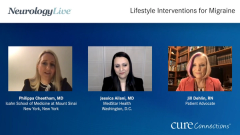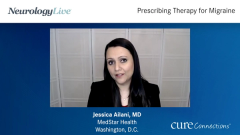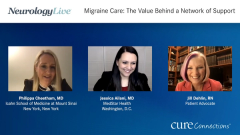
Migraine Care: The Value Behind a Network of Support
A patient advocate, Jill Dehlin, RN, explains why patients with migraine should connect with other patients via patient support programs and take a proactive role in managing their condition.
Episodes in this series

Philippa Cheetham, MD: We have talked a lot about what we have learned from these new drugs, including the science and research behind them. We have shared our own stories. I wanted to ask you, in this final segment, about patients circling back to each other and self-help groups or blogs. It is a very small world, and migraine is so common, yet when you are in an attack and you are the only person who cannot make the party or go out to dinner, you can feel so alone. Do you think there are certain ways that individual sufferers can connect with each other to learn more by educating through their own journey, as opposed to just patients reaching out to experts in the field?
Jill Dehlin, RN: My internet connection is unstable.
Philippa Cheetham, MD: I was interested to know, we have talked a lot about patients connecting with specialists, but obviously patients who have been through their own journeys have walked this path. We always say that a smart person learns from somebody else, but a wise person learns from other people’s mistakes as well as their own.
Jill Dehlin, RN: One of the gratifying things about being an advocate is—because I have walked those miles, and I wish I had had someone like me to help me when I was first diagnosed because there was so much trial and error—having a network of support with other people who are going through your same journey or a similar journey. Honestly, some of the friends I have made as a migraine advocate are some of my best friends, and I know that we are going to be friends for life. We help each other, we educate each other, and we pick each other up when we are feeling down. I honestly do not know what my life would be like without my network of other people with migraine.
Philippa Cheetham, MD: You have given a huge amount of your own personal time. How do you get the support or the infrastructure to be available to so many people? Do you have any formal funding or support for your network?
Jill Dehlin, RN: I do a lot of volunteer work with different organizations in the migraine space. I am on the board of the National Headache Foundation. I am the Patient Leadership Council chair for that organization. I am on the board of the Alliance for Headache Disorders Advocacy. We do an annual Headache on the Hill Day in Washington DC, and I am also working with CHAMP [Coalition for Headache and Migraine Patients] as a volunteer to help develop materials for students to avoid stigma. It is called migraineatschool.org, and I am really proud of that. I volunteer for Miles for Migraine, an organization that has support groups. Before COVID-19 they had in-person support groups, and now they have Zoom support groups. It is good to know you are not alone because it is such an isolating disease.
Philippa Cheetham, MD: Well, I am very relieved to hear that, when you started talking about Miles for Migraine, you were not going to sign Dr Ailani and me up to do an Ironman triathlon with you to raise money for migraine charities. This has been an absolutely fantastic session. Often, with these series and educational materials, the more information we learn, the more questions I have. Certainly, the future seems very bright, and it is really wonderful to hear that research is going on that has brought these medications to the forefront of clinical practice.
One wish of mine would be to try to marry the clinical expertise that you have in the profession with advocates like Jill, because I think that as clinicians, with the best will in the world, we can write a script. We can say “Try this, try that,” and these medications can be very effective, but I think there is a need for multidisciplinary care. It is important to be spending time talking to patients, especially if it is from somebody who has experienced these journeys, these medications, and the quality-of-life effects. We help each other address the big picture and not just write a prescription and say, “Let’s see how this goes.” I thank you so much for your time, and I really look forward to getting feedback through Cure Connections® from people who tune into this segment. This is a wealth of information. Thank you so much, Dr Ailani and Jill, for your wonderful education and really valuable insights.
Thank you for watching NeurologyLive® Cure Connections®. If you enjoyed the program, please subscribe to our e-newsletter to receive upcoming programs and other great content right in your inbox. Thank you so much.
Transcript Edited for Clarity
Newsletter
Keep your finger on the pulse of neurology—subscribe to NeurologyLive for expert interviews, new data, and breakthrough treatment updates.












































